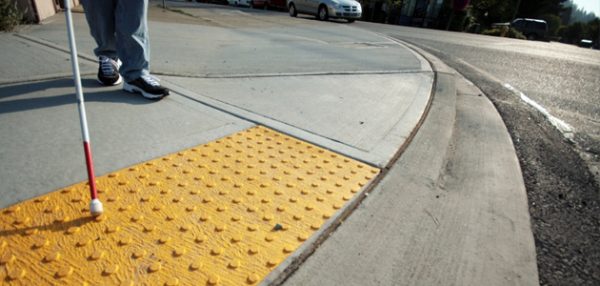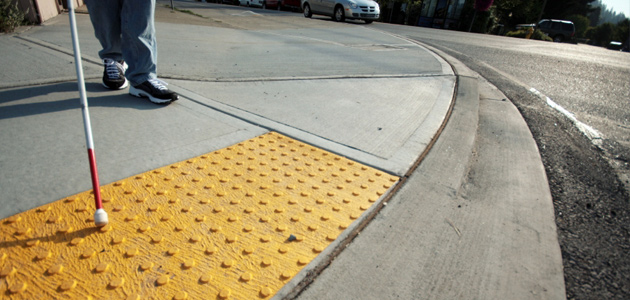
New Zealand has just ratified the Paris climate agreement and pledged to reduce its emmissions by 30% below 2005 levels by 2030. Hopefully, this will, among other things, spur on our current government’s promising efforts to increase the use of hybrid and electric vehicles in our country.
With my environmental activist hat on, I welcome this shift. With my blind pedestrian hat on, on the other hand, I greet this trend with apprehension.
Unless these cars are fitted with so-called Acoustic Vehicle Alerting Systems (AVAS), they are virtualy silent when travelling below 32 km/h. The noise levels of entirely electric vehicles don’t increase radically after that, either.
So what’s the situation in New Zealand?
As of March this year, New Zealand is bound by new regulations under the 1958 Agreement which mean that all quiet vehicles sold in our country have to have an AVAS installed. This is great. It means that the vehicles, when travelling at low speeds, can emit vrrrroom-y sounds that indicate to the blind pedestrian that they exist.
The bad news is that those cars are also allowed to have a driver-controled switch determining whether the AVAS is being used or not. Unfortunately we have human subjects as proof that introducing these switches isn’t acceptable: last year a blind Japanese man was killed when a reversing truck had its beeping device switched off, while another blind man from England was unlucky enough to get hit on two separate occasions by the same hybrid car because he couldn’t hear it coming. Fortunately, I have been reliably informed the world Blind Union’s lobbying efforts to prohibit this pause switch are going well.
Once we have all those quiet vehicles making more noise, won’t we have solved the problem?
It’ll be a great start, but … No. In the world of decibels, not even all gas-powered forms of transport were born equal. Next time you are walking down a busy street, or waiting for a bus, listen (and look, too, please!) … what can you hear? What can’t you hear?
Everything you can see but not hear is invisible to blind pedestrians like me. All the cars you barely hear, we only get glimpses of.
Do you really need to hear those cars, though? Don’t traffic lights take care of that problem?
Not entirely. Try crossing one of those commercial driveway/parking-lots that rudely interrupt your footpath meanderings while an apparently endless stream of buses wizzes past your roadside ear. Or how about when the traffic lights don’t make noise and there’s no-one around?
These are real-life scenarios. As a test subject for the first, I managed to misjudge the reversing of a car stopped right across the footpath. Happily, it was my cane, and not my foot, that got jammed under one of the tyres. The driver didn’t bother apologizing, either. In the second, one of my friends from the US was waiting for ages at a crossing where the lights weren’t sounding, despite his previous complaints to Council on the issue. He and his blind friend did their best to choose a safe moment to cross but got it wrong and the friend ended up in critical condition (she’s much better now).
These sorts of close calls are by and large preventable, though. On another occasion when I was crossing one of these footpath-stealing driveways where the driver of the car was blocking my path, that driver did something really radical. She put down her window and directed me verbally around her car.
Quite apart from the fact that her instructions removed the human obstacle more promptly, letting her get wherever she needed to be faster, they also made me feel far less stressed. Thanks to the ten seconds of her time she granted my safety, I could navigate around the car confidently, safe in the knowledge that my white cane and the car tyres would not engage in another game of Russian roulette.
What’s the take-home message?
Every time you are operating a form of transport other than your own two feet, you are more powerful than pedestrians. You have the power to make blind footpath-users feel extremely unsafe.
But if you talk to us, you also have the power to make us feel considerably less apprehensive.
If I know where you are, and I know you know I can’t see you, I’ll feel much safer. Speaking up is a worthy endeavour. The energy I didn’t expend playing ‘should I stay or should I go?’ will be dutifully funnelled into improving the quality of future blog posts…






That’s a good point, and one that probably few people have stopped to consider.
And its not just people who have hearing or visual disabilities either. If you drive “quiet” vehicle you also have to be careful of the masses who walk or cycle around with earphones attached/inserted almost oblivious to what is going on around them. They can’t even hear a diesel bus coming so they certainly won’t be hearing a hybrid or electric car.
But as you say there are solutions, unfortunately you can be sure that the added cost of these solutions will create resistance in some circles. Look at the initial furore when taxis had to get cameras installed.
Good article Aine, lots to think about there.
When the risk factor is as high as human lives, I would hope that all people would realize that we can’t play games over financial cost on that. At least in theory, that shouldn’t have to be a political issue.
I’m told by a Chinese friend that electric bicycles sold in China have an unofficial nickname which roughly translates to ‘whispering death’. They can do up to 40kph and often go on the pavement…
Oh, God. I’ll think I’ll stick to advocacy within NZ, for the time being…
This is stuff I have also been thinking about and concerned about. Silent cars may be nice in a way, but our blind fellow citizens will face a new challenge to deal with.
So this matter needs some serious consideration, I think.
It’s enlightening to hear from your perspective on these matters, Aine. I’ve noticed some of these points too, though not so sharply of course.
I walk everywhere wherever possible. I’m extremely careful, and yet I regularly have near-misses with cars. Just the other day I was walking along the footpath, and almost got taken out by an almost silent, modern, “zippy” small car coming quickly out of an indoor parking lot. I noticed the driver was a young pakeha female, bling’d to the brim, and couldn’t help but wonder if where she was heading in such a hurry was worth it.
Honestly I find walking anywhere near cars to be dangerous. There’s just a huge amount of casualness and hurrying from drivers. So it’s very thoughtful to hear from you and consider these same events from the perspective of a blind person, as well as the other things you’ve mentioned here. Out walking, I can’t help but observe it to be a microcosm of class differentiation. We urgently need to slow down the pace of our society, simplify, and return to the fundamentals.
Thanks for the good read.
Yes–if the stakes alone weren’t bad enough, the silence of hybrid/electric vehicles is annissue that affects all pedestrians to some extent. Glad the car missed you!
It’s not just the electric vehicles on the road either, but also the new NZ Post electric delivery vehicles which use the footpath (are these required to be audible?), and mobility scooters driven by usually infirm, and often partially sighted drivers. How long will it be before someone is killed or seriously injured?
Good question, thanks for raising this… I don’t know if they come under the regulations already in place or not … I will ask our World Blind Union rep.
I’ve been concerned about the dangers of silent vehicles since the first electric bus went into use in Ōtautahi about a decade ago. I’m a sighted pedestrian, but I still use my hearing a lot to determine when I need to be scanning for vehicles, and when I can (in theory) just relax and wander along. The obvious solution is the Acoustic Vehicle Alerting Systems (AVAS) mentioned by Áine. Parliament needs to be pass legislation obliging any motorized vehicle used in NZ to be fitted with one that can’t be turned off.
I can imagine these system having options for the vehicle owner to pick their preferred engine noise, or replace it with music, the same way people can with their cell phone ringtones. The systems could also be set up so the volume gets louder the faster the vehicle is going, which would give further information to pedestrians, and subtly discourage speeding by making it acoustically obvious.
Yup. At least in the short-term, it’d be good if they stick to engine-like noises though – we don’t want to have to pause to process that, say Mama Mia = moving vehicle (tempting as vustomizable ringtone sounds are…).
Comments are closed.